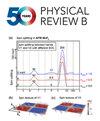Electronic structure and properties of trapped holes in crystalline and amorphous Ga2O3
IF 3.7
2区 物理与天体物理
Q1 Physics and Astronomy
引用次数: 0
Abstract
Structure and electronic properties of self-trapped holes were studied in both crystalline and amorphous Ga2O3 using density functional theory (DFT) and the nonlocal PBE0-TC-LRC density functional. Amorphous (a)晶体和非晶Ga2O3中捕获空穴的电子结构和性质
利用密度泛函理论(DFT)和非局部 PBE0-TC-LRC 密度泛函研究了晶体和非晶态 Ga2O3 中自俘获空穴的结构和电子特性。利用经典分子动力学和熔淬技术生成了无定形 (a) Ga2O3 结构,并利用 DFT 对其进行了进一步优化。它们的平均密度为 4.84g/cm3,带隙约为 4.3eV。计算结果表明,结晶和非晶相中的空穴捕获都很深,非晶结构中的空穴捕获能比结晶结构中的空穴捕获能更深。在 a-Ga2O3 中,捕获空穴集中在低配位氧原子(二配位或三配位)周围。我们预测在晶体和非晶相中都会形成稳定的空穴双极子,其结合能约为 0.2 eV。 美国物理学会出版 2025
本文章由计算机程序翻译,如有差异,请以英文原文为准。
求助全文
约1分钟内获得全文
求助全文
来源期刊

Physical Review B
物理-物理:凝聚态物理
CiteScore
6.70
自引率
32.40%
发文量
0
审稿时长
3.0 months
期刊介绍:
Physical Review B (PRB) is the world’s largest dedicated physics journal, publishing approximately 100 new, high-quality papers each week. The most highly cited journal in condensed matter physics, PRB provides outstanding depth and breadth of coverage, combined with unrivaled context and background for ongoing research by scientists worldwide.
PRB covers the full range of condensed matter, materials physics, and related subfields, including:
-Structure and phase transitions
-Ferroelectrics and multiferroics
-Disordered systems and alloys
-Magnetism
-Superconductivity
-Electronic structure, photonics, and metamaterials
-Semiconductors and mesoscopic systems
-Surfaces, nanoscience, and two-dimensional materials
-Topological states of matter
 求助内容:
求助内容: 应助结果提醒方式:
应助结果提醒方式:


